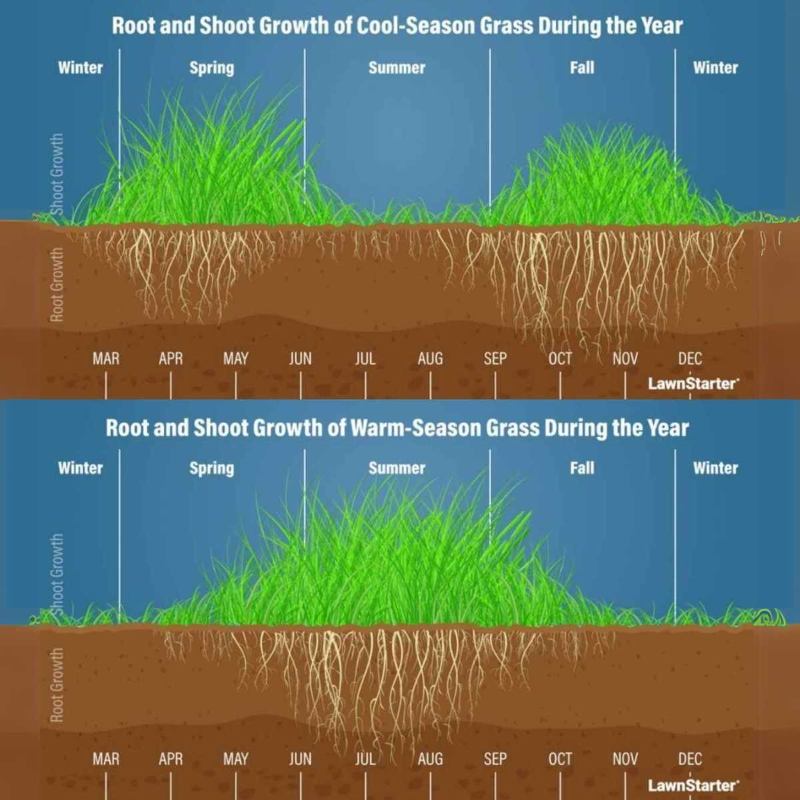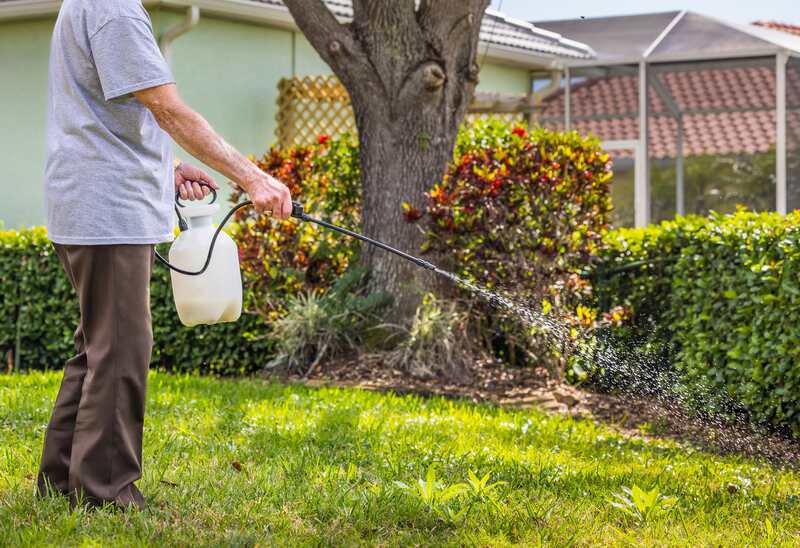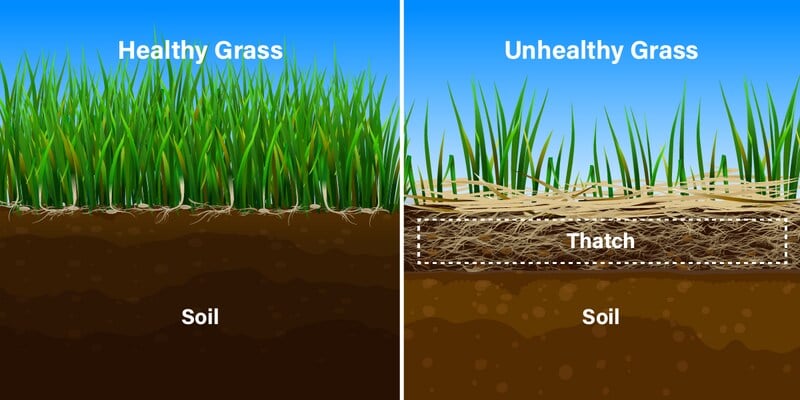
Fall lawn care sets the stage for a healthy spring lawn. LawnStarter’s fall lawn care checklist covers 10 tasks, from proper mowing techniques to soil testing, with specific guidelines for both cool-season and warm-season grasses.
So grab your rake or leaf blower, and let’s get started. As an added bonus, our lawn care pros share their fall lawn care tips, tricks, and why these 10 seasonal tasks are important.
Oh, and if you’d rather not risk straining your back raking leaves or lose time with these other fall lawn care tasks, our local lawn care pros and local leaf removal crews can take these jobs off your to-do list.
1. Manage Falling Leaves
What’s the most important thing you should do now? Remove or mulch all those leaves.
Here’s why:
“It is important to remove leaves from your yard because if they accumulate, they can block sunlight and trap moisture, creating a perfect environment for mold, pests, and lawn diseases,” says LawnStarter pro Sergio Beltran of Gio’s Multitask Lawn & Landscaping in Clearwater, Florida.
“Removing leaves regularly helps your lawn breathe, stay healthy, and look clean year-round,” he says.
LawnStarter pro Jose Tovar of Tovar Landscaping in Fort Worth, Texas, agrees: “My No. 1 tip for lawn maintenance in the fall is to have your lawn clear of leaves so that it doesn’t develop spots with missing grass.”
During peak fall season, rake leaves or mulch-mow them weekly. If you choose to mulch them with your mower, make sure they’re dry and chop them into small pieces that fall between the grass blades.
See Related:
— What Happens if You Don’t Remove Leaves
— How to Deal with the Neighbor’s Leaves in Your Yard
— Tips for Cleaning Up Leaves in Your Yard
2. Mow Until Grass Stops Growing

Continue mowing your lawn until growth stops for the year. “Do not pause service too early. In my experience, spring and fall get the most growth,” says LawnStarter pro Jason Reyes of Royal Lawn and Landscape in Dallas.
When to put your mower in the garage or shed (or mow less through winter) depends on where you live and your grass type:
- Cool-season grasses (northern U.S.) grow until air temperature drops below 40 or 42 degrees (typically October). Mow at the recommended height through the fall, and for the final cut of the season, lower the height to 2 or 2.5 inches.
- Warm-season grasses (southern U.S.) go dormant when air temperatures drop below 60 to 65 degrees (typically in November). Mow them at the recommended height until they go dormant, and then make the final cut about 1/2-inch longer to protect crowns from cold damage.
In the southernmost regions of the U.S., you may have to mow periodically through the winter, as grass growth doesn’t completely stop.
| Cool-Season Grasses | Recommended Mowing Height |
| Kentucky Bluegrass | 2.5 to 3.5 inches |
| Tall Fescue | 2 to 3 inches |
| Fine Fescue | 2 to 3 inches |
| Perennial Ryegrass | 1.5 to 2.5 inches |
| Warm-Season Grasses | Recommended Mowing Height |
| Bahiagrass | 3 to 4 inches |
| Common Bermudagrass | 1.5 to 2.5 inches |
| Hybrid Bermudagrass | 0.5 to 1.5 inches |
| Buffalograss | 2 to 3 inches |
| Carpetgrass | 0.75 to 2 inches |
| Centipedegrass | 1 to 2 inches |
| St. Augustine | 2.5 to 3 inches |
| Zoysiagrass | 1 to 2 inches |
See Related: Mowing Height Debate: Last Mow of the Season Low?
3. Treat and Control Weeds

Fall is a great time to tackle perennial weeds, as they are actively storing energy in their roots. Therefore, when you apply herbicide, it’s more likely to be absorbed into the roots and be effective.
Apply post-emergent herbicides like 2,4-D to target dandelions, clover, and other broadleaf weeds. Spot treatment is better than broadcasting with a lawn spreader. You can also apply a pre-emergent herbicide to prevent annual weeds like henbit and chickweed.
My Tip: Be judicious with chemical weed control in warm-season lawns. These grasses have a limited ability to recover from potential damage since they aren’t growing as much in the fall as cool-season types.
4. Remove Excess Thatch

Lawns benefit from dethatching when the thatch layer exceeds 1/2 inch, as excessive buildup prevents water and nutrients from reaching roots. The best time to dethatch your lawn varies significantly between grass types.
- Cool-season grasses should be dethatched in early fall — late August through September — when they’re still actively growing and can recover before winter dormancy.
- Warm-season grasses should be dethatched in late spring to early summer when they’re in peak growing condition. A light dethatching can be done in early fall if absolutely necessary.
Use a power rake for small areas or rent a dethatcher for larger lawns. Leave about 1/4-inch of thatch to help retain soil moisture and provide cushioning.
It’s normal for your lawn to look a little rough after dethatching. It should bounce back within 2 to 4 weeks. If need be, follow up with overseeding and fertilization to help fill in any thin or bare spots.
5. Aerate Compacted Soil

“Aeration is one of the best things to do for your lawn,” says LawnStarter pro John Murtagh of John and Tara Little Lawn Care in New Port Richey, Florida. “It helps break the soil up in the ground and get the oxygen and the water down to the soil of the yard. It helps the yard grow better.”
How do you know if your soil needs aerating? Push a screwdriver into the ground to check for soil compaction. If it requires significant force to push the screwdriver into the soil, you ground needs aeration. Other signs your lawn needs to be aerated include water pooling on the surface, heavy thatch buildup, and poor grass growth despite proper care.
Aeration timing and techniques are different between grass types. The key is to time it with the most prolific growth.
- Aerate cool-season lawns from September through November. This timing takes advantage of fall moisture and moderate temperatures, which drive growth. Aerate heavily used lawns yearly, and moderate traffic areas every 2 to 3 years.
- Aerate warm-season grasses in late spring through early summer, not fall.
See Related: How to Aerate Your Lawn
6. Overseed
“Overseed with ryegrass to help protect the turf from potential freezing temps,” says LawnStarter pro Jonathan Alvarado of Alvarado’s Lawn Care in Mesquite, Texas.
The best time to overseed varies between grass types.
Cool-season grasses are great candidates for fall overseeding. The ideal window is late August through mid-October. Soil temperatures are still warm enough for germination, and cooler air temps reduce stress on new seedlings. These are common cool-season grasses:

Warm-season grasses should not be overseeded in the fall, unless you are planting cool-season varieties for winter color. The soil temperatures are too cold now for warm-season types. These are common warm-season grasses:

Apply seed at the recommended label rate, ensuring good seed-to-soil contact. Water lightly and frequently until germination occurs. Then transition to deeper, less frequent watering. Avoid heavy foot traffic on newly seeded areas for 6 to 8 weeks.
See Related: How to Overseed a Lawn in 8 Simple Steps
7. Test Your Soil
Before you put down a fall fertilizer, test the soil.
Fall soil testing provides valuable information that you can use to build the coming year’s lawn care program. You can use the nitrogen, phosphorus, and potassium results to help tailor a fertilizer program to the needs of your grass and prevent over-application. Plus, fall testing gives lime or sulfur amendments time to adjust soil pH before spring.
Collect soil samples from multiple locations across your lawn (sample 4 to 6 inches deep for established lawns), mixing them for a representative sample. Then use an at-home soil test kit, or send the sample to a professional lab for analysis.
My Tip: If you’re testing the soil yourself, contact your local Cooperative Extension office and talk to an Extension educator. They can help guide you through the ideal soil pH for your grass type and calculate fertilizer rates based on your results.
See Related: How to Read a Soil Test Report
8. Apply a Fall Fertilizer for Strong Roots

“Fertilize your lawn.” That’s the No. 1 tip from LawnStarter pro Philip Heinz of Go Green Electric Lawn Care of Mesquite, Texas. “It helps the grass finish the season strong.”
Your fall fertilizer strategy is going to differ significantly depending on whether you have a cool-season or warm-season lawn, as the different grass types have very different needs.
Cool-Season Grass Fertilization
Cool-season lawns like Kentucky bluegrass or perennial ryegrass benefit tremendously from a low-nitrogen, high-potassium fertilizer in October through November. A fertilizer ratio of 5-10-5 or similar is a good option.
This “winterizer” fertilizer helps your grass store energy in the roots and crowns, improving its cold tolerance and promoting earlier green-up in the spring. The low nitrogen keeps your grass from having a growth spurt when it’s trying to slow down for the season; potassium strengthens cell walls to improve drought and cold tolerance.
Warm-Season Grass Fertilization
Warm-season lawns like Bermuda or bahiagrass benefit from a balanced fertilizer (N, P, and K are in similar amounts) in August through September. Avoid applying fertilizer in late fall as the nitrogen stimulates new growth that is vulnerable to frost.
| Hire a LawnStarter fertilizer pro to take fertilization off your busy fall to-do list for about $103 per service. Local lawn fertilization pros completed nearly 40,000 jobs last year, earning a 4.4 rating from our customers. |
See Related:
— When is the Best Time to Apply Fall Fertilizer?
— How to Choose the Best Fall Lawn Fertilizer
9. Adjust Lawn Watering
It’s necessary to adjust how you water in the fall, but exactly how you change depends on your lawn type.
Watering basics:
- Water deeply and less frequently
- Let rainfall take over
- Water less as grass growth slows
- Time the last watering before frost or freeze
Instead of following a rigid irrigation schedule, monitor the soil moisture, as fall weather can be unpredictable.
Cool-Season Lawn Watering
Cool-season grasses remain active longer into fall than their warm-season counterparts, so you’ll need to water them longer. Especially if you’ve overseeded or are experiencing dry conditions, remember, they do most of their growing when temperatures are cooler.
Stop regular irrigation once soil temperatures consistently stay below 40 degrees.
My Tip: If you live in Idaho, an area with harsh winters, watch the forecast and give your lawn one last hearty drink before the ground freezes.
Warm-Season Lawn Watering
Warm-season lawns go dormant earlier in the season, so you’ll begin reducing water needs sooner. Gradually decrease frequency in early fall, allowing the grass to harden off for winter.
Once you see signs of dormancy (e.g., browning), stop watering entirely unless you’re facing drought conditions. Then water once a month to keep the crowns and roots from drying out.
10. Winterize Sprinklers
While not a task specifically geared toward the grass, you’ll also want to prep your sprinkler system for winter if you live in an area with freezing temperatures.
Our sprinkler winterizing guide walks you through the steps, but the basic concept is to drain all the water out of your sprinklers to prevent freezing. As you know, water expands when it freezes and can crack or break lines, valves, or sprinkler heads, resulting in expensive sprinkler repair costs.
Need Help Getting Your Fall Lawn Care Done?

Fall lawn care can feel overwhelming, but you don’t have to tackle it alone. Whether you need help with aeration, leaf removal, mowing, or the entire checklist, LawnStarter connects you with trusted local lawn care professionals who know your grass type and climate. Get matched with qualified pros in your area and enjoy a healthier lawn come spring.
And from this fall to next, what’s the secret to a perfect lawn? “Keep up with cutting it on a schedule, and don’t bag your clippings. Mulch them up and spread them around your yard. That’s the best fertilizer,” says LawnStarter pro Bradley Rearden of Rearden Landscape and Maintenance in Midlothian, Texas.
Main Image: Illustration by Whitney Lehnecker / LawnStarter; Photo by Sasha / Adobe Stock